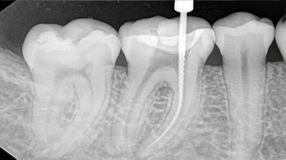Welcome to Bryant Park Endodontics
Dr. Bui was recognized on CBS’s American Health Front on Oct 1, 2016
Having performed over 15,000 root canals, Dr. Young Bui is one of Manhattan’s premier endodontists – a specialist in the art of root canal therapy.
Our goal is to provide our patients with the most technologically advanced endodontic treatment available anywhere. Our “make no compromises” philosophy places our practice in the top 1% of endodontic practices, nationwide.
We are committed to providing you with a comfortable atmosphere during treatment and we strive to make every visit to our office as pleasant as possible. Our aim is to deliver gentle endodontic care to our patients.
By referring you to our office, your dentist has shown their concern that you receive the finest endodontic care possible. Our goal is to provide unsurpassed quality in a compassionate environment of professionalism and clinical excellence. We hope to exceed your expectations.
Why Regular Dental Checkups Help Prevent Root Canals
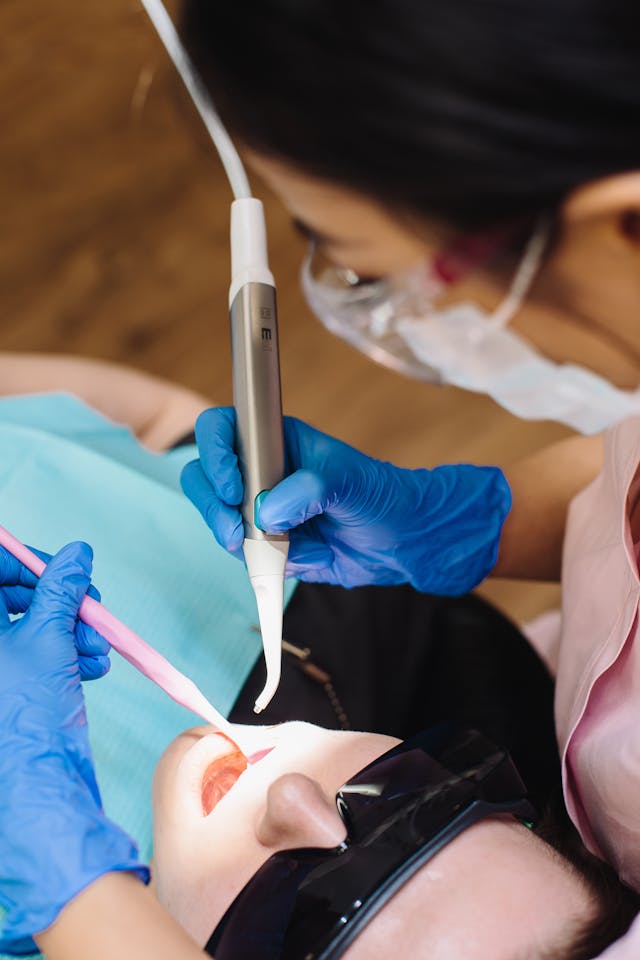 This blog explores why regular dental checkups help prevent root canals and its significance in modern dentistry. Root canal therapy is often misunderstood, yet it remains one of the most effective ways to save a natural tooth from extraction. By addressing infections within the tooth pulp, this procedure restores oral health and prevents further complications.
This blog explores why regular dental checkups help prevent root canals and its significance in modern dentistry. Root canal therapy is often misunderstood, yet it remains one of the most effective ways to save a natural tooth from extraction. By addressing infections within the tooth pulp, this procedure restores oral health and prevents further complications.
When Is a Root Canal Necessary?
Root canals are necessary when the pulp inside your tooth becomes infected or damaged. This can occur due to deep decay, repeated dental procedures on the same tooth, or trauma. Symptoms such as severe pain, prolonged sensitivity, and swelling in the gums often indicate the need for this procedure.
Understanding the Root Canal Procedure
- Diagnosis: During your initial consultation, X-rays and a thorough examination help identify the affected tooth and the extent of the damage.
- Procedure: The infected pulp is removed, and the canals are cleaned, shaped, and sealed to protect against further infection.
Benefits of Choosing Root Canal Therapy
- Minimized Pain: Modern technology and local anesthesia make root canals virtually pain-free.
- Preserving Natural Teeth: Unlike extractions, root canals allow you to keep your natural tooth structure intact.
- Long-Term Success: With proper care, a root canal-treated tooth can last a lifetime.
Post-Treatment Care for Root Canals
After the procedure, it’s essential to follow your dentist’s instructions for recovery. Maintain good oral hygiene, avoid chewing on the treated tooth until it’s restored with a crown, and attend follow-up appointments to monitor healing.
Root Canals vs. Extractions: Which is Better?
Root canals are often a better option than extractions because they preserve the integrity of your jawbone and surrounding teeth. Extraction, on the other hand, can lead to complications like shifting teeth and the need for costly replacements like implants.
Contact Us Today
Ease your anxiety with expert care. Dr. Young Bui, DDS specializes in pain-free root canals—call to schedule today!
Young Bui, DDS
30 East 40th Street Suite 1201
New York, NY 10016
646-205-3045
Drendo4u@yahoo.com
Managing Anxiety Before a Root Canal Procedure
Managing anxiety before a root canal procedure is essential for ensuring a calm, positive experience and a smooth recovery. Dental anxiety is incredibly common—especially when it comes to endodontic treatments like root canals. Fortunately, modern dentistry offers several strategies to help you feel more relaxed and in control before and during your appointment.

Understanding the Root Canal Process
A key step in managing anxiety is understanding what the procedure actually involves. Many people fear root canals because of outdated information or misconceptions.
- Painless Procedure: Thanks to local anesthesia and modern techniques, most root canals are no more painful than a routine dental filling.
- Quick and Effective: The majority of root canals can be completed in one or two appointments, with minimal downtime.
- Tooth-Saving: A root canal helps preserve your natural tooth, prevent extraction, and eliminate infection or pain.
Knowing what to expect can take much of the fear out of the unknown.
Tips for Reducing Dental Anxiety Before a Root Canal
-
Speak With Your Endodontist
Clear communication with your dental provider is crucial. Discuss your concerns in advance—let them know if you have had a bad experience or if you’re feeling particularly nervous. A good endodontist will take the time to explain each step of the procedure and tailor your visit to your comfort level.
-
Practice Breathing and Relaxation Techniques
Deep breathing, mindfulness, or guided meditation exercises can help you stay calm leading up to and during your appointment. Even a few minutes of focused breathing can slow your heart rate and reduce anxiety symptoms.
-
Bring Comfort Items
Consider bringing headphones to listen to calming music, an audiobook, or a podcast during the procedure. Having a comfort item, like a stress ball or blanket, can also help ease tension.
-
Avoid Stimulants
Steer clear of caffeine or energy drinks before your appointment, as these can heighten anxiety and make it harder to relax in the chair.
-
Ask About Sedation Options
If your anxiety is severe, your endodontist may offer mild sedation, such as nitrous oxide (laughing gas), oral anti-anxiety medication, or even IV sedation in certain cases. Discuss these options during your consultation to determine what’s best for you.
Benefits of Managing Your Anxiety
By actively managing your dental anxiety, you’ll enjoy a more comfortable and successful procedure. Benefits include:
- Better communication with your care team
- Lower pain perception and reduced physical stress
- Faster recovery and healing
- Improved confidence for future dental visits
Conclusion
Root canal therapy no longer needs to be a source of fear. With the right preparation, open communication, and relaxation strategies, managing anxiety before a root canal procedure can make a significant difference in your experience. Remember, your endodontic team is there to support you every step of the way.
Let Bryant Park Endodontics Help You Feel at Ease
At Bryant Park Endodontics, Dr. Young Bui and our compassionate team are committed to patient comfort. We offer advanced root canal treatment in a calming, supportive environment—always tailored to your specific needs and concerns.
Take the first step toward stress-free dental care by contacting us today:
Bryant Park Endodontics
Young Bui, DDS
30 East 40th Street Suite 1201
New York, NY 10016
Phone: 646-205-3045
Email: Drendo4u@yahoo.com
Website: https://youngbuidds.com
The Importance of Saving Natural Teeth Through Root Canals
What are the facts regarding saving natural teeth through root canals? When a tooth becomes severely decayed or infected, many patients assume extraction is the only option. However, modern endodontic treatment offers a powerful alternative: the root canal. Root canals are not just about relieving pain—they’re about preserving the structure and function of your natural teeth. In this article, we’ll explore why saving your natural teeth through root canal therapy is often the best decision for your long-term oral health.
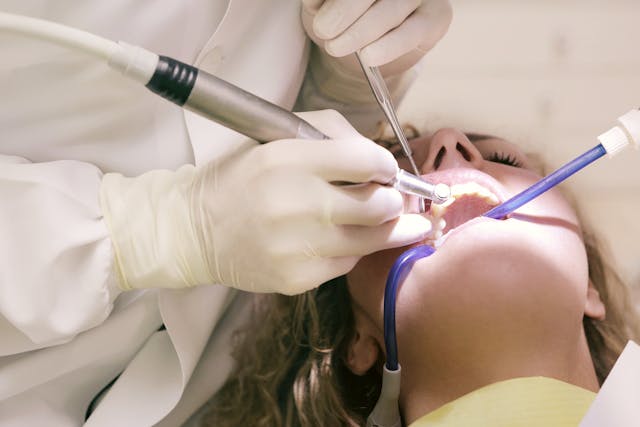
Why Natural Teeth Are Worth Saving
Your natural teeth are uniquely designed to support proper function, aesthetics, and jaw health. Replacing them—even with high-quality dental implants—can never fully replicate the biological performance of a natural tooth. Here’s why natural tooth preservation matters:
- Chewing Efficiency: Natural teeth maintain optimal biting and chewing ability, helping you eat comfortably and enjoy a full range of foods.
- Jawbone Health: A natural tooth root helps stimulate and preserve jawbone tissue. When a tooth is extracted, bone loss in the area is likely to follow.
- Maintains Natural Alignment: Saving your tooth helps keep surrounding teeth in place, preventing shifting and bite issues.
- Preserves Facial Structure: Tooth loss can lead to sunken cheeks and premature aging. Keeping your natural teeth helps maintain your facial profile.
What Is Root Canal Treatment?
Root canal therapy is a dental procedure that treats infection or inflammation within the pulp (inner tissue) of a tooth. Instead of extracting the tooth, an endodontist removes the infected pulp, cleans the root canal space, and seals the tooth to prevent future infection.
- Diagnosis: The endodontist uses digital imaging to assess the extent of infection.
- Cleaning: The infected pulp is removed, and the canals are disinfected.
- Sealing: The canals are filled with a biocompatible material and sealed.
- Restoration: A crown or filling is placed to restore the tooth’s function and appearance.
Advantages of Choosing a Root Canal Over Extraction
While both root canals and extractions are effective treatments, preserving your natural tooth offers numerous advantages:
- Less Invasive: A root canal is less traumatic to the surrounding bone and gum tissue compared to an extraction followed by a prosthetic replacement.
- More Cost-Effective Long-Term: Although root canals may seem more expensive initially, avoiding tooth replacement options (like implants or bridges) can reduce costs over time.
- Quick Recovery: Most patients recover quickly from root canal treatment and experience immediate relief from pain.
- High Success Rate: Root canals have a long track record of success when properly performed and restored with a crown or filling.
Signs You Might Need a Root Canal
If you experience any of the following symptoms, it may be time to consult an endodontist:
- Severe, lingering tooth pain—especially when chewing
- Extreme sensitivity to hot or cold
- Swollen or tender gums near a tooth
- Darkening or discoloration of a tooth
- Recurring pimples or abscesses on the gum
Conclusion
Root canal therapy is not just a treatment—it’s a way to preserve the natural foundation of your smile. Saving your tooth helps retain its natural function, protects your overall dental structure, and eliminates pain caused by infection or inflammation. Choosing a root canal over extraction, when appropriate, is a decision that prioritizes your long-term oral health.
Preserve Your Smile with Expert Endodontic Care in NYC
At Bryant Park Endodontics, Dr. Young Bui and our team specialize in advanced root canal therapy to save natural teeth whenever possible. We’re committed to delivering comfortable, effective care using the latest technologies and techniques.
Schedule your consultation today and take the first step toward preserving your natural smile:
Bryant Park Endodontics
Young Bui, DDS
30 East 40th Street Suite 1201
New York, NY 10016
Phone: 646-205-3045
Email: Drendo4u@yahoo.com
Website: https://youngbuidds.com
Root Canals vs. Tooth Extractions: Making the Right Choice
How do you choose between root canals vs tooth extractions? When a tooth becomes severely decayed, infected, or damaged, your dentist may present you with two main options: a root canal or a tooth extraction. Understanding the differences between these two treatments—and the long-term impact of each—can help you make an informed decision that supports your oral health and overall well-being.
What Is a Root Canal?
A root canal is a procedure performed by an endodontist to save a tooth that has become infected or inflamed in its pulp (the innermost layer). The procedure involves:
- Removing the infected or damaged pulp
- Cleaning and disinfecting the root canal space
- Sealing the tooth with a biocompatible material
- Restoring the tooth with a crown or filling to protect it
Benefits of a Root Canal:
- Preserves your natural tooth
- Maintains normal chewing function and jaw structure
- Eliminates pain while maintaining aesthetics
- High success rate with long-term stability
What Is a Tooth Extraction?
A tooth extraction involves removing the entire tooth from its socket. This procedure is typically recommended when a tooth is too damaged to be saved or when infection has spread extensively.
- Local anesthesia is used to numb the area
- The tooth is gently loosened and removed from the socket
- The area is disinfected and sutured (if needed)
- In most cases, tooth replacement options like implants or bridges are considered afterward
Reasons for Extraction Over a Root Canal:
- Tooth is too structurally compromised to restore
- Severe bone loss around the tooth
- Persistent infection despite prior root canal therapy
- Cost considerations in the short term
Comparing Long-Term Outcomes
| Aspect | Root Canal | Tooth Extraction |
|---|---|---|
| Preserves Natural Tooth | ✅ Yes | ❌ No |
| Chewing Efficiency | Maintained | May decrease without replacement |
| Aesthetics | Natural look preserved | May require prosthetic restoration |
| Cost Over Time | Moderate, especially if crown is needed | May increase with implant or bridge |
| Healing Time | Minimal recovery needed | Longer, especially with surgical extractions |
Which Option Is Right for You?
Choosing between a root canal and an extraction depends on multiple factors:
- The extent of the tooth damage or infection
- The strategic importance of the tooth (e.g., molars vs. wisdom teeth)
- Your overall oral and general health
- Budget and insurance coverage
- Your long-term goals for your smile and function
Root canal therapy is generally preferred when the tooth can be saved. However, extraction may be the better choice if the tooth is beyond repair or poses a risk to adjacent teeth and tissues.
Conclusion
Root canals and extractions are both effective solutions for managing severe tooth damage or infection. However, preserving your natural tooth with a root canal often leads to better long-term results in terms of functionality, appearance, and oral health. Consulting with an experienced endodontist can help you weigh the options and choose the treatment that’s best for your situation.
Get Expert Advice from NYC’s Trusted Endodontic Team
At Bryant Park Endodontics, Dr. Young Bui and our team specialize in advanced root canal therapy and diagnostic care to help you make the right decision for your oral health. If you’re experiencing pain, sensitivity, or have been told you need a root canal or extraction, we’re here to guide you through every step.
Schedule your consultation today:
Bryant Park Endodontics
Young Bui, DDS
30 East 40th Street Suite 1201
New York, NY 10016
Phone: 646-205-3045
Email: Drendo4u@yahoo.com
Website: https://youngbuidds.com
Caring for Your Tooth After a Root Canal
In this article, we’ll guide you through everything you need to know about caring for your tooth after a root canal to promote a smooth and speedy recovery. A root canal is a highly effective procedure used to save a damaged or infected tooth. While the treatment removes the source of pain and infection, proper aftercare is crucial to ensure the tooth heals properly and remains healthy long term.
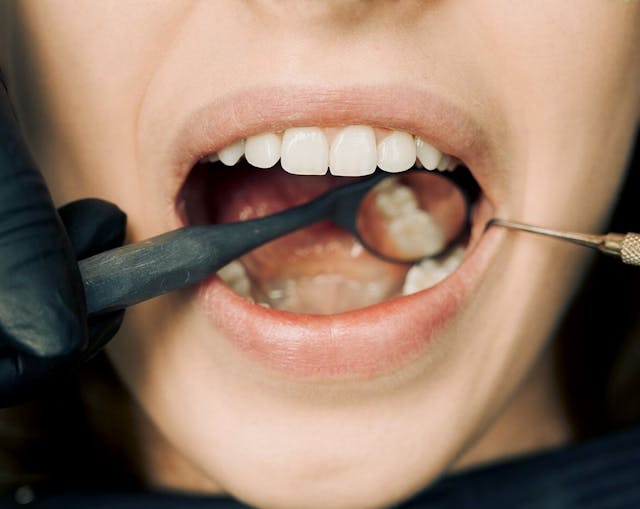
What to Expect After a Root Canal
Following the procedure, it’s normal to experience some sensitivity, mild discomfort, or tenderness around the treated tooth. These symptoms typically subside within a few days and can be managed with over-the-counter pain medication as directed by your dentist or endodontist.
Post-Procedure Care Tips
-
Wait Until the Numbness Wears Off
Avoid chewing or drinking anything hot until the local anesthesia completely wears off. This prevents accidental biting of your tongue or cheek and reduces the risk of burns or irritation.
-
Eat Soft Foods
Stick to soft, non-chewy foods for the first few days. Great options include soup, mashed potatoes, yogurt, eggs, smoothies, and steamed vegetables. Avoid sticky, crunchy, or hard foods that could damage the temporary filling or tooth.
-
Maintain Oral Hygiene
Continue brushing and flossing as usual, but be gentle around the treated area. Keeping your mouth clean helps prevent infection and supports healing. Consider using an antiseptic mouthwash if recommended by your dentist.
-
Manage Discomfort
It’s common to feel mild pain or pressure in the treated area. Over-the-counter pain medications like ibuprofen or acetaminophen can help. If the discomfort worsens or persists longer than a few days, contact your dentist or endodontist.
-
Avoid Smoking and Alcohol
Smoking can delay healing and increase the risk of complications. Alcohol may interfere with medications and should be avoided for a few days after treatment.
Restoring the Treated Tooth
After a root canal, the treated tooth is typically sealed with a temporary filling. A follow-up appointment is essential to place a permanent restoration—most commonly a dental crown.
- Why You Need a Crown: A crown protects the tooth from fracture, restores full chewing function, and improves long-term durability.
- Don’t Delay Restoration: Delaying the permanent restoration can increase the risk of reinfection or structural damage.
Signs of Complications
Monitor your recovery and contact your dentist or endodontist if you experience any of the following:
- Severe or worsening pain
- Prolonged swelling or tenderness
- Visible swelling or pus in the gums
- Cracked or chipped restoration
Early intervention can prevent complications and ensure the long-term success of your root canal treatment.
Long-Term Care for Your Treated Tooth
Maintaining excellent oral hygiene is key to preserving your treated tooth:
- Brush twice a day with fluoride toothpaste
- Floss daily to remove plaque between teeth
- Visit your dentist every 6 months for check-ups and cleanings
- Protect your teeth from trauma—use a mouthguard if you grind your teeth or play contact sports
Caring for Your Tooth After a Root Canal: Conclusion
A root canal doesn’t just relieve pain—it saves your natural tooth and restores oral health. With proper post-procedure care and long-term maintenance, your treated tooth can last a lifetime. By following your dentist’s instructions, getting the necessary restoration, and practicing good oral hygiene, you’ll set yourself up for a smooth recovery and lasting results.
Need Follow-Up Care or Have Questions?
At Bryant Park Endodontics, Young Bui, DDS, and our experienced team are committed to helping patients recover comfortably and successfully after root canal treatment. Whether you need aftercare support, a follow-up restoration, or have questions about your symptoms, we’re here to help.
Contact us today to schedule your post-root canal appointment:
Bryant Park Endodontics
Young Bui, DDS
30 East 40th Street Suite 1201
New York, NY 10016
Phone: 646-205-3045
Email: Drendo4u@yahoo.com
The Role of Advanced Technology in Modern Endodontics
Let’s explore the role of advanced technology revolutionizing modern endodontics and how they benefit both patients and clinicians. Endodontics has undergone a transformative evolution in recent years, driven by advancements in dental technology. These innovations have made diagnosing and treating complex tooth conditions more accurate, efficient, and comfortable for patients. In modern endodontic practices, like Bryant Park Endodontics, cutting-edge tools are reshaping the way root canal therapy and other procedures are performed—ultimately leading to better outcomes and higher patient satisfaction.
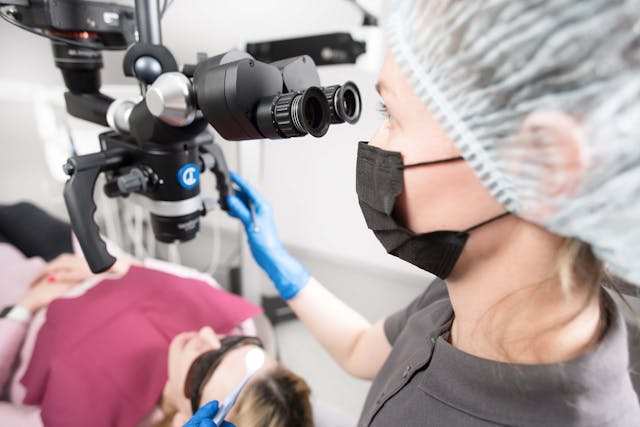
1. Cone Beam Computed Tomography (CBCT)
Cone Beam CT scanning is one of the most significant advancements in endodontics. This 3D imaging technology provides detailed views of teeth, bone structures, and surrounding tissues with far greater clarity than traditional X-rays.
- Benefits:
- Enables precise diagnosis of root fractures, missed canals, or hidden anatomy
- Improves treatment planning, especially in complex cases
- Reduces the risk of retreatment by providing full visual clarity
2. Dental Operating Microscopes
The use of dental microscopes allows endodontists to view the internal anatomy of a tooth at high magnification. This enhanced visibility is critical when locating hidden or calcified canals that could be missed with the naked eye.
- Benefits:
- Greater precision in cleaning and shaping root canals
- Improved detection of fractures or anatomical anomalies
- Higher treatment success rates
3. Digital Radiography
Digital X-rays have replaced traditional film-based imaging in most modern dental offices. These high-resolution images can be viewed instantly and offer lower radiation exposure for patients.
- Benefits:
- Real-time diagnosis and treatment planning
- Enhanced image storage and sharing capabilities
- Reduced environmental waste
4. Nickel-Titanium Rotary Instruments
Traditional hand files have largely been replaced by nickel-titanium (NiTi) rotary instruments. These motor-driven tools are more flexible and efficient, allowing endodontists to clean and shape curved canals with greater ease.
- Benefits:
- Minimizes procedural errors like canal transportation
- Shortens procedure time
- Improves patient comfort
5. Ultrasonic Endodontics
Ultrasonic instruments are used to agitate irrigating solutions and enhance the cleaning of the root canal system. This technology is particularly useful in removing debris from hard-to-reach areas within the tooth.
- Benefits:
- More effective removal of bacteria and debris
- Supports better disinfection and sealing of the canal
6. GentleWave® Technology
GentleWave is an innovative system that uses multisonic energy and fluid dynamics to clean root canals more thoroughly than traditional techniques. It’s particularly beneficial for patients seeking a minimally invasive yet highly effective procedure.
- Benefits:
- Deeper cleaning with less instrumentation
- Preservation of more natural tooth structure
- Reduced post-treatment discomfort
7. Electronic Apex Locators
Apex locators help determine the exact length of the root canal space, ensuring the root canal is filled completely and accurately.
- Benefits:
- Reduces dependence on repeated radiographs
- Improves accuracy in root canal obturation
Advanced Technology in Modern Endodontics: Conclusion
Technology is at the heart of modern endodontics, allowing for safer, faster, and more effective treatments than ever before. From 3D imaging and ultrasonic cleaning to the latest in rotary instrumentation, today’s endodontists have access to tools that were unimaginable a generation ago.
At Bryant Park Endodontics, we are committed to staying on the leading edge of endodontic care by incorporating the latest technology into every aspect of our practice. Whether you need a root canal, retreatment, or trauma care, you can trust that you’re receiving the highest standard of treatment available today.
Experience State-of-the-Art Endodontics in New York City
Discover how advanced technology can make your root canal experience more comfortable and successful. Schedule your appointment with Dr. Young Bui and the experienced team at Bryant Park Endodontics today.
Bryant Park Endodontics
Young Bui, DDS
30 East 40th Street Suite 1201
New York, NY 10016
Phone: 646-205-3045
Email: Drendo4u@yahoo.com
Preventing Tooth Decay and Root Canal Treatments
In this article, we’ll explore ways of preventing tooth decay and avoid the need for root canal treatments. Tooth decay is one of the most common oral health issues affecting both children and adults. Left untreated, it can progress deep into the tooth, potentially reaching the pulp and requiring root canal therapy. The good news? Tooth decay is largely preventable with the right habits and dental care.
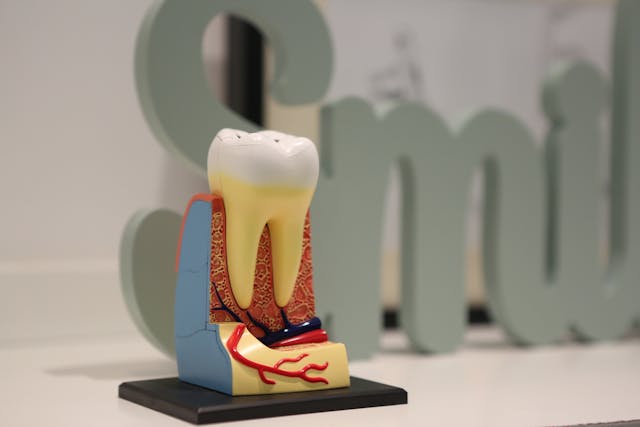
Understanding Tooth Decay and Its Consequences
Tooth decay occurs when harmful bacteria in the mouth produce acids that erode the enamel, leading to cavities. If cavities are not treated in their early stages, decay can penetrate deeper into the tooth, eventually reaching the pulp—the inner soft tissue that houses nerves and blood vessels. When this happens, the pulp can become infected or inflamed, and a root canal treatment may be the only way to save the tooth.
Top Causes of Tooth Decay
- Poor oral hygiene habits
- Frequent consumption of sugary or acidic foods and drinks
- Inadequate fluoride exposure
- Dry mouth or reduced saliva production
- Not visiting the dentist regularly
Tips to Prevent Tooth Decay and Root Canal Therapy
-
Brush and Floss Daily
Brush your teeth at least twice a day using fluoride toothpaste, and floss once daily to remove food particles and plaque from between the teeth and under the gumline.
-
Use Fluoride Products
Fluoride strengthens enamel and helps prevent cavities. Use fluoride toothpaste and consider mouth rinses that contain fluoride for added protection.
-
Limit Sugary and Acidic Foods
Sugars and acids fuel the bacteria responsible for tooth decay. Avoid frequent snacking and minimize sugary drinks like soda and juice. Opt for water and tooth-friendly snacks like cheese, nuts, and vegetables.
-
Stay Hydrated
Drinking plenty of water helps maintain saliva production, which plays a key role in neutralizing acids and washing away food particles.
-
Visit Your Dentist Regularly
Routine dental check-ups and cleanings allow your dentist to catch decay in its early stages and treat it before it requires more extensive care like a root canal.
-
Consider Dental Sealants
Dental sealants are thin, protective coatings applied to the chewing surfaces of back teeth. They’re especially helpful for children but can benefit adults as well by preventing decay in hard-to-clean areas.
When Prevention Isn’t Enough
Despite best efforts, decay can sometimes progress due to genetics, underlying medical conditions, or unnoticed cavities. If a cavity goes untreated and reaches the pulp, you may experience symptoms such as:
- Severe toothache or sensitivity to hot and cold
- Swelling in the gums
- Darkening of the tooth
- A persistent pimple or abscess on the gums
If these signs are present, a root canal may be necessary to save the tooth and prevent extraction.
Preventing Tooth Decay and Root Canal Treatments: Conclusion
Preventing tooth decay is the most effective way to avoid needing a root canal. With proper oral hygiene, regular dental visits, and healthy habits, you can significantly reduce your risk of cavities and preserve your natural teeth for life. Prevention is not only better for your health—it’s also less costly and invasive than treatment.
Partner with Bryant Park Endodontics for Expert Dental Care
At Bryant Park Endodontics, Young Bui, DDS, and our experienced team are committed to helping you maintain healthy teeth and gums. Whether you’re looking to prevent dental issues or need specialized endodontic care, we’re here to provide gentle, expert treatment tailored to your needs.
Ready to prioritize your oral health? Contact us today to schedule an evaluation or consultation:
Bryant Park Endodontics
Young Bui, DDS
30 East 40th Street Suite 1201
New York, NY 10016
Phone: 646-205-3045
Email: Drendo4u@yahoo.com
Website: https://youngbuidds.com
Common Misconceptions About Root Canals Debunked
In this article, we’ll debunk some of the most common misconceptions about root canals and set the record straight—using facts backed by modern dental science. Root canal therapy has long been surrounded by fear, myths, and misinformation. Despite being a routine and highly successful dental procedure, many patients still associate root canals with pain, complications, and unnecessary treatment.

Understanding Root Canals
A root canal is a dental procedure used to treat infection or inflammation inside a tooth. It involves removing the damaged or infected pulp, cleaning and disinfecting the root canals, and sealing the space to prevent further infection. Thanks to modern techniques and anesthesia, root canals today are safe, effective, and relatively painless.
Top Misconceptions About Root Canals
-
Myth 1: Root Canals Are Extremely Painful
Fact: Thanks to advances in local anesthesia and modern technology, root canal procedures are no more painful than getting a filling. The purpose of a root canal is to relieve pain—not cause it. Most patients report that the procedure itself is comfortable and that the pain they feared was already from the infected tooth, not the treatment.
-
Myth 2: It’s Better to Pull the Tooth
Fact: Saving your natural tooth is almost always the best option. Extraction can lead to other dental issues, including shifting teeth, bite misalignment, and the need for more costly treatments like implants or bridges. A successful root canal allows you to preserve your natural tooth and maintain proper oral function.
-
Myth 3: Root Canals Cause Illness
Fact: This myth originated from flawed studies conducted nearly 100 years ago. Modern research has shown no link between root canal treatment and systemic diseases. In fact, eliminating infection in your mouth can improve your overall health by reducing the body’s inflammatory burden.
-
Myth 4: Root Canals Require Multiple Visits
Fact: Many root canals can be completed in just one or two visits, depending on the complexity of the case. With digital imaging, rotary instruments, and better materials, the procedure has become much more efficient and streamlined.
-
Myth 5: The Results Don’t Last
Fact: When performed properly and followed by a good restoration—such as a crown—root canals can last a lifetime. Maintaining good oral hygiene and visiting your dentist for regular checkups also significantly improve long-term outcomes.
How to Know If You Need a Root Canal
- Severe tooth pain when chewing or applying pressure
- Prolonged sensitivity to hot or cold
- Darkening or discoloration of the tooth
- Swelling or tenderness in nearby gums
- A recurring pimple on the gums
If you experience any of these symptoms, a visit to an endodontist can help determine whether a root canal is necessary and prevent the issue from worsening.
Common Misconceptions About Root Canals: Conclusion
Don’t let outdated myths keep you from saving your natural tooth and protecting your overall oral health. Root canal treatments today are safe, comfortable, and highly effective. Understanding the truth behind these common misconceptions can help you make informed decisions about your dental care.
Need Expert Endodontic Care in New York City?
At Bryant Park Endodontics, Young Bui, DDS, and our team of skilled endodontists specialize in modern root canal therapy using the latest techniques and technology. We are committed to patient comfort, accurate diagnosis, and successful long-term outcomes. If you’re experiencing tooth pain or need a second opinion, we’re here to help.
Contact us today to schedule your consultation:
Bryant Park Endodontics
Young Bui, DDS
30 East 40th Street Suite 1201
New York, NY 10016
Phone: 646-205-3045
Email: Drendo4u@yahoo.com
Website: https://youngbuidds.com/
Recognizing the Signs: Do You Need a Root Canal?
 What are the signs that you need a root canal? Root canal therapy is a crucial part of modern dentistry, offering a highly effective way to save a natural tooth that would otherwise require extraction. By treating infections within the tooth’s pulp, this procedure restores oral health and prevents further complications. This blog will explore the key signs indicating you might need a root canal and explain the importance of this procedure.
What are the signs that you need a root canal? Root canal therapy is a crucial part of modern dentistry, offering a highly effective way to save a natural tooth that would otherwise require extraction. By treating infections within the tooth’s pulp, this procedure restores oral health and prevents further complications. This blog will explore the key signs indicating you might need a root canal and explain the importance of this procedure.
When Is a Root Canal Necessary?
Root canals become necessary when the pulp inside your tooth becomes infected or damaged. This can occur due to several factors, including:
- Deep tooth decay that has reached the pulp.
- Repeated dental procedures on the same tooth.
- Trauma or injury to the tooth.
Several symptoms can indicate the need for a root canal:
- Severe, persistent tooth pain, especially when chewing or applying pressure.
- Prolonged sensitivity to hot or cold, even after the source is removed.
- Swelling or tenderness in the gums surrounding the affected tooth.
If you are experiencing any of these symptoms, it is essential to consult a dentist as soon as possible.
Understanding the Root Canal Procedure
The root canal procedure typically involves the following steps:
- Diagnosis: During your initial consultation, X-rays and a thorough examination will help identify the affected tooth and the extent of the damage.
- Procedure: The infected pulp is removed, and the canals are cleaned, shaped, and sealed to protect against further infection.
Benefits of Choosing Root Canal Therapy
Root canal therapy offers several significant benefits:
- Minimized Pain: Modern technology and local anesthesia make root canals virtually pain-free.
- Preserving Natural Teeth: Unlike extractions, root canals allow you to keep your natural tooth structure intact.
- Long-Term Success: With proper care, a root canal-treated tooth can last a lifetime.
Post-Treatment Care for Root Canals
After a root canal procedure, proper post-treatment care is essential for successful healing and long-term success:
- Follow your dentist’s instructions for recovery.
- Maintain good oral hygiene, including regular brushing and flossing.
- Avoid chewing on the treated tooth until it’s restored with a crown.
- Attend follow-up appointments to monitor healing.
Root Canals vs. Extractions: Which is Better?
Root canals are often a better option than extractions for preserving your oral health. Here’s why:
- Root canals preserve the integrity of your jawbone and surrounding teeth.
- Extractions can lead to complications like shifting teeth and the need for costly replacements like implants.
Signs You Need a Root Canal: Contact Us Today
Toothache? Swollen gums? Let Young Bui, DDS provide expert root canal care. Call now to book your visit!
Young Bui, DDS
30 East 40th Street Suite 1201
New York, NY 10016
646-205-3045
Drendo4u@yahoo.com
Preparing for Your Root Canal: A Guide to a Smooth Experience
This guide will walk you through the process of preparing for a root canal, ensuring you feel confident and informed every step of the way. Root canal therapy is a valuable procedure in modern dentistry, designed to save your natural teeth from extraction. It addresses infections within the tooth’s pulp, restoring oral health and preventing further complications.

Recognizing the Need for a Root Canal
Several indicators can signal the need for root canal treatment. These often arise from pulp damage, which can be caused by:
- Extensive tooth decay that reaches the pulp.
- Multiple dental procedures on the same tooth, weakening its structure.
- Trauma to the tooth, even without visible cracks or chips.
- Cracks or fractures in the tooth that allow bacteria to enter.
Look out for these common symptoms:
- Persistent, throbbing tooth pain, especially when biting or applying pressure.
- Increased sensitivity to hot or cold, lingering even after the stimulus is removed.
- Swelling or tenderness in the gums surrounding the affected tooth.
- Discoloration of the tooth, often appearing darker than usual.
If you’re experiencing any of these signs, it’s crucial to seek professional dental care promptly. Early intervention can prevent the infection from spreading and improve the chances of successfully saving your tooth.
Understanding the Root Canal Journey
The root canal procedure involves several key steps:
- Initial Evaluation: Your dentist will conduct a thorough examination, including X-rays, to assess the damage and determine if a root canal is necessary. They may use advanced imaging techniques for a more detailed view.
- Anesthesia Administration: Local anesthesia will be administered to numb the area, ensuring a comfortable and pain-free experience.
- Accessing the Pulp Chamber: A small opening is created in the tooth to access the infected pulp.
- Cleaning and Shaping the Canals: The infected pulp is carefully removed, and the root canals are cleaned and shaped to prepare them for filling.
- Filling the Canals: The cleaned canals are filled with a biocompatible material to seal them and prevent future infection.
- Restoration with a Crown: A crown is typically placed over the tooth to restore its strength, function, and appearance.
The Benefits of Saving Your Natural Tooth
Choosing root canal therapy offers significant advantages over extraction:
- Pain Elimination: The procedure targets the source of your pain, providing effective and lasting relief.
- Natural Tooth Preservation: Keeping your natural tooth maintains your bite, alignment, and overall oral health.
- Long-Term Solution: With proper care, a root canal-treated tooth can last a lifetime.
- Cost-Effectiveness: While there is an investment, preserving your natural tooth often avoids more extensive and expensive restorative work later on.
Post-Treatment Care and Recovery
After your root canal, follow these guidelines for optimal healing:
- Adhere to your dentist’s instructions for pain management and oral hygiene.
- Maintain a consistent brushing and flossing routine.
- Avoid chewing on hard or sticky foods until your permanent crown is placed.
- Attend all scheduled follow-up appointments.
Root Canal vs. Extraction: A Critical Decision
While extraction might seem like a quicker solution, it can lead to several complications:
- Bone Loss: Missing teeth can cause the jawbone to deteriorate.
- Tooth Shifting: Adjacent teeth can shift into the empty space, affecting your bite and alignment.
- Need for Replacements: Extractions often require costly replacements like implants or bridges.
Preserving your natural tooth through root canal therapy is generally the preferred option for maintaining long-term oral health and function.
Taking the Next Step
If you suspect you might need a root canal, don’t hesitate to seek professional dental care. Early diagnosis and treatment are key to a successful outcome.
Preparing for Your Root Canal: Contact Us Today
Schedule your appointment with Dr. Young Bui, DDS, to discuss your options and receive expert care.
Young Bui, DDS
30 East 40th Street Suite 1201
New York, NY 10016
646-205-3045
Drendo4u@yahoo.com




